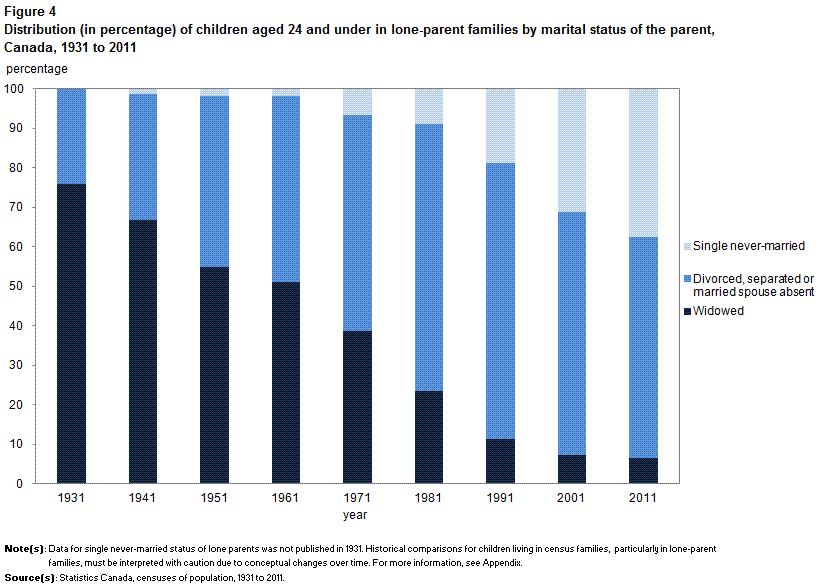Publications
Demographic Documents
Enduring Diversity: Living Arrangements of Children in Canada over 100 Years of the Census
Post-baby boom to the end of the 20th century
Archived Content
Information identified as archived is provided for reference, research or recordkeeping purposes. It is not subject to the Government of Canada Web Standards and has not been altered or updated since it was archived. Please "contact us" to request a format other than those available.
By the end of the 1960s, events such as the legalization of the birth control pill as well as the growing participation of women in higher education and in the paid labour force occurred. The declining influence of religion also affected family life. In Quebec in particular, this increased secularization, which occurred in conjunction with other societal and cultural changes, has become known as the Quiet Revolution. Together, these events contributed to later family formation, smaller family sizes and an increased diversity of family structures compared to the preceding baby-boom period. As the ‘dual-earner’ model of paid work became more prevalent among couples, parental work arrangements and the time available to spend with family changed markedly from preceding decades.Note 30
Additionally, there was a large increase in the number of divorces following the 1968 Divorce Act, which introduced no-fault divorce based on separation of three years or more. Previously, divorce was a relatively uncommon path to lone parenthood. A second large increase in divorces occurred in the late 1980s following the amendment to this legislation that reduced the minimum separation time to one year.Note 31
Reflecting some of these societal changes, the share of children living with a lone parent more than doubled from 1961 (6.4%) to 1991 (15.2%). Over this period, the legal marital status of lone parents also changed considerably. In 1961, about half (51.0%) of children in lone-parent families lived with a widowed lone parent, already down from about three-quarters (75.9%) in 1931. Thirty years later, widowed lone parents were the exception, representing about one in ten (11.2%) children in lone-parent families in 1991 (Figure 4). Instead, the majority of children in lone-parent families, 70.0%, lived with a parent who was divorced, separated or married (spouse absent) in 1991; another 18.8% lived with a lone parent whose marital status was single never-married.Note 32

Along with the marital status of lone parents, the predominance of female lone parents has varied considerably over time. While lone parents have always been more likely to be female, in the early decades of the 20th century, relatively high maternal mortality contributed to proportionally more male lone parents being enumerated compared to later in the century (Figure 5). By the 1990s, among children in lone-parent families, the proportion that were living with a male lone parent reached its lowest observed level: 15.5% lived with a male lone parent in 1996, compared with 28.1% in 1941.

In addition to the increased share of lone-parent families, children’s living arrangements appeared to become more diverse when common-law couples were first measured in the 1981 Census. In some cases, individuals choose to live in a common-law relationship as a precursor to, or ‘testing ground’, for eventual marriage. Increasingly however, common-law unions have become a more permanent alternative form of cohabitation for many couples—whether they have been previously married or not—and one in which children may be raised. Between 1981 and 1991, the proportion of children living with common-law couple parents more than doubled, from 2.6% to 5.9%. Despite their increased prevalence, common-law unions in Canada remain more likely to dissolve than married unions, and there is some evidence that children living with common-law parents during this time experienced a higher risk of family dissolution, and at a younger age, than those born into a union of married parents.Note 33
Notes
- Lapierre-Adamcyk, E., N. Marcil-Gratton et C. Le Bourdais. 2006. “A Balancing Act: Parents’ Work Arrangements and Family Time”, Canada’s Changing Families: Implications for Individuals and Society, editors K. McQuillan and Z. R. Ravanera, University of Toronto Press, pages 49 to 75.
- Milan, A. 2013. “Marital status: Overview, 2011”, Report on the Demographic Situation in Canada, Statistics Canada Catalogue no. 91-209-X.
- Single never-married status includes those lone parents that have separated from a previous common-law partner.
- Marcil-Gratton, N. 1998. Growing up with Mom and Dad? The intricate family life courses of Canadian children, Statistics Canada Catalogue no. 89-566-XIE. Marcil-Gratton, N. and C. Le Bourdais. 1999. Custody, access and child support: Findings from the National Longitudinal Survey of Children and Youth, Research Report Child Support Team CSR-1999-3E, Ottawa, Department of Justice. Bohnert, N. 2011. “Examining the determinants of union dissolution among married and common-law unions in Canada”, Canadian Studies in Population, volume 38 (3-4), pages 91 to 109.
- Date modified:
